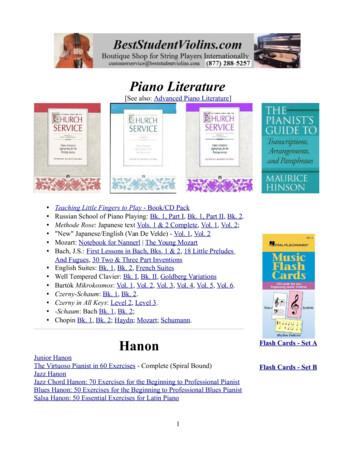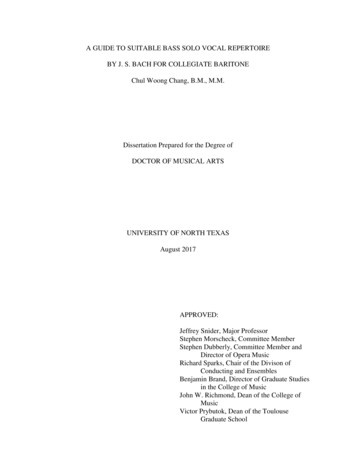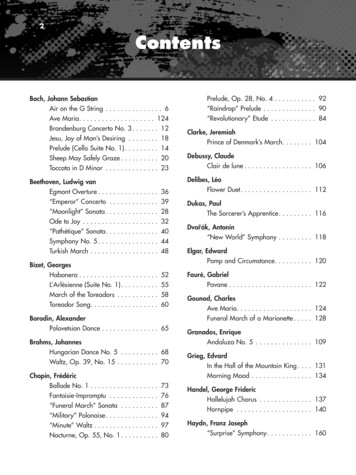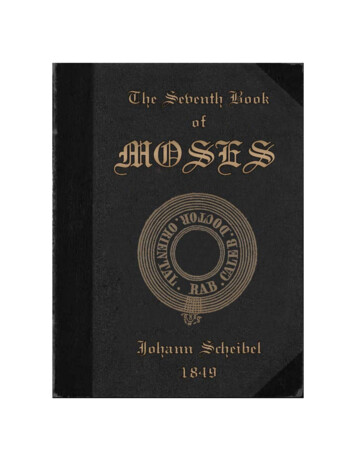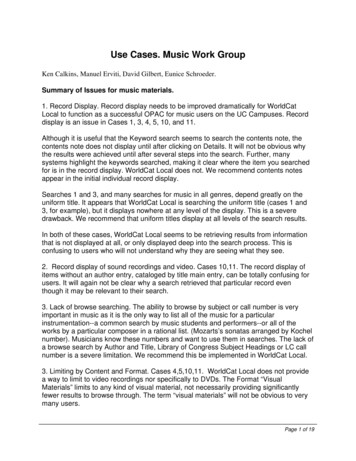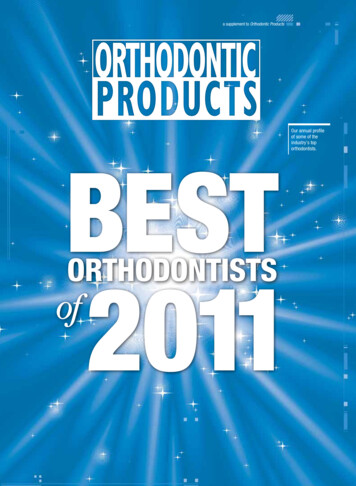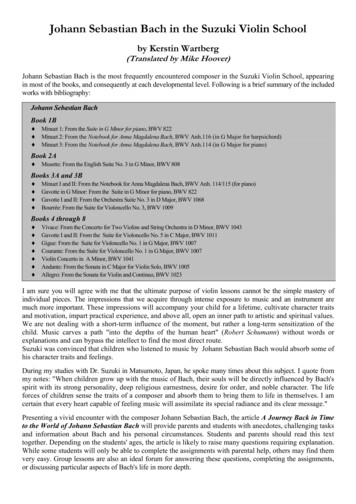
Transcription
Johann Sebastian Bach in the Suzuki Violin Schoolby Kerstin Wartberg(Translated by Mike Hoover)Johann Sebastian Bach is the most frequently encountered composer in the Suzuki Violin School, appearingin most of the books, and consequently at each developmental level. Following is a brief summary of the includedworks with bibliography:Johann Sebastian BachBook 1Bi Minuet 1: From the Suite in G Minor for piano, BWV 822i Minuet 2: From the Notebook for Anna Magdalena Bach, BWV Anh.116 (in G Major for harpsichord)i Minuet 3: From the Notebook for Anna Magdalena Bach, BWV Anh.114 (in G Major for piano)Book 2Ai Musette: From the English Suite No. 3 in G Minor, BWV 808Books 3A and 3BiiiiMinuet I and II: From the Notebook for Anna Magdalena Bach, BWV Anh. 114/115 (for piano)Gavotte in G Minor: From the Suite in G Minor for piano, BWV 822Gavotte I and II: From the Orchestra Suite No. 3 in D Major, BWV 1068Bourrée: From the Suite for Violoncello No. 3, BWV 1009Books 4 through 8iiiiiiiVivace: From the Concerto for Two Violins and String Orchestra in D Minor, BWV 1043Gavotte I and II: From the Suite for Violoncello No. 5 in C Major, BWV 1011Gigue: From the Suite for Violoncello No. 1 in G Major, BWV 1007Courante: From the Suite for Violoncello No. 1 in G Major, BWV 1007Violin Concerto in A Minor, BWV 1041Andante: From the Sonata in C Major for Violin Solo, BWV 1005Allegro: From the Sonata for Violin and Continuo, BWV 1023I am sure you will agree with me that the ultimate purpose of violin lessons cannot be the simple mastery ofindividual pieces. The impressions that we acquire through intense exposure to music and an instrument aremuch more important. These impressions will accompany your child for a lifetime, cultivate character traitsand motivation, impart practical experience, and above all, open an inner path to artistic and spiritual values.We are not dealing with a short-term influence of the moment, but rather a long-term sensitization of thechild. Music carves a path "into the depths of the human heart" (Robert Schumann) without words orexplanations and can bypass the intellect to find the most direct route.Suzuki was convinced that children who listened to music by Johann Sebastian Bach would absorb some ofhis character traits and feelings.During my studies with Dr. Suzuki in Matsumoto, Japan, he spoke many times about this subject. I quote frommy notes: "When children grow up with the music of Bach, their souls will be directly influenced by Bach'sspirit with its strong personality, deep religious earnestness, desire for order, and noble character. The lifeforces of children sense the traits of a composer and absorb them to bring them to life in themselves. I amcertain that every heart capable of feeling music will assimilate its special radiance and its clear message."Presenting a vivid encounter with the composer Johann Sebastian Bach, the article A Journey Back in Timeto the World of Johann Sebastian Bach will provide parents and students with anecdotes, challenging tasksand information about Bach and his personal circumstances. Students and parents should read this texttogether. Depending on the students' ages, the article is likely to raise many questions requiring explanation.While some students will only be able to complete the assignments with parental help, others may find themvery easy. Group lessons are also an ideal forum for answering these questions, completing the assignments,or discussing particular aspects of Bach's life in more depth.
Parents and teachers can further encourage their children and students to develop an interest in the world ofmusic by providing appropriate books and recordings, with portraits of composers created especially foryoung audiences. It might also be inspiring to listen to recordings of original versions of works by Bach,especially those pieces appearing in the Suzuki Violin School. (Please see the list above.)Original Compositions andArrangements in the ongplayers and audiences can oftenbe found in a variety ofarrangements. In the BaroquePeriod, it was considered anhonor for a composer whencolleagueswouldmakearrangements of his works. Afterthe motto "All is permitted thatpleases!", no less a figure than J.S. Bach made arrangements ofhalf of the 12 Vivaldi concertosop. 3 (one for four violins, twofor three violins and three for oneviolin) for piano, organ, or evenfour harpsichords with stringorchestra.He transposed some of thesepieces into different keys,changedbasslinesandharmonies, fashioned figures tobe more virtuosic, and evenadded or deleted measures.See the direct comparison on theright. The lower system is byVivaldi, the upper one shows itsarrangement by Bach.Bach's pupil, Johann Friedrich Agricola, wrote in the year 1775 that Bach often played his pieces for violinor violoncello solo on the clavichord (a forerunner of the piano) adding chordal accompaniments to themelody. (See Johann Nikolaus Forkel: From the first biography in 1802 about Bach, Bärenreiter-Verlag,Kassel 2004). So it is certainly not a stylistic offence to include in book 3 the Bourrée from the Suite No. 3for Violoncello Solo as an arrangement for violin and piano in this book. This is simply a continuation ofBach's own frequent practice and is reminiscent of his free spirit.Arrangements in Instrumental PedagogyWhen students like a piece, they are much more willing to work intensively on difficult passages and tacklechallenging technical issues like bow speed, string crossings, tempo and intonation. This is whyarrangements can be such valuable additions to the lesson repertoire. Expecting students to polish etudes tothe same high levels of mastery at this stage of development will usually exhaust their perseverance andenthusiasm rather quickly.
The Written Music as Foundation for Our WorkAlthough Suzuki frequently challenged teachers to act freely and creatively in their manner of teaching, hedid want them to remain faithful to certain elements. One of these was adherence to the common repertoireused by Suzuki students throughout the world, which has enabled them to communicate in the commonlanguage of music for many years. This thought is further embodied in the homogeneity of the worldwidestudent and teacher training and has great merit. Nevertheless, movements for change have emerged andsome Suzuki materials are coming on the market with alternative versions and different editions of somepieces.Faksimile der Bourrée aus der Suite Nr. 3 für Violoncello solo, Abschrift von Anna Magdalena Bach
There is no Bach autograph (Urtext) of the suites for cello. Here, you see the earliest source, a copy from1727 in the hand of Anna Magdalena Bach.The Revised Edition of the Violin School Volume 3 will come on the market shortly. In it, you will findalternative versions of Gavotte I and II and the Bourrée by J. S. Bach.Upon closer examination of the three different versions of the Bourréei Facsimilei the transcription in the original Suzuki Violin School, 1978 Editioni the transcription in the Revised Edition 2008it is easy to see that none of the transcriptions may claim to be consistent with the facsimile edition, not tomention the fact that they have been transposed from the cello to the violin.I am convinced that Johann Sebastian Bach, and Shinichi Suzuki as well, would have been extremely happyto hear children around the world play these pieces together, regardless of the arrangement. Both wouldhave placed primary emphasis on the quality and musicality of the performances. In the interest of ourchildren and students, we should not lose sight of these goals.Kerstin WartbergDirector of the German Suzuki Institute
Supplementary Material for Suzuki Violin StudentsSTEP BY STEPAn Introduction to Successful PracticeViolin Exercise Books with Companion CDsAlfred PublicationsThe CDs include almost all pieces from the Suzuki Violin School,volumes 1-3, as well as important preparatory exercises and additionalpieces in various tempi. Volumes 1A & 1B are suitable for students in Suzuki Book 1. Volumes 2A & 2B are suitable for students in Suzuki Book 2. Volumes 3A & 3B are suitable for students in Suzuki Book 3 Piano Accompaniments: www.musicdownloaddirect.deThe STRAD, September 2005:This fascinating series of tutor books is closely based on the Suzuki Violin Method. The series is suitable for teacherswell versed in the Suzuki method, but will also be of interest to those coming to it fresh, because of Wartberg'sdetailed notes.I liked the useful advice for teachers and parents, and the descriptions of some effective technical exercises, whichall looked great fun. The quality of the CD performances is good, with some interesting sound effects and drumrhythms that are sure to engage younger players RECITAL TRAININGViolin Repertoire Books with Companion CDsEdition PetersThe CDs include all pieces from the Suzuki Violin School, volumes 4& 5, as well as important preparatory exercises and additional pieces invarious tempi.EP11291EP11292MY TRIO BOOK Volume 1 is suitable for students in Suzuki Book 4. Volume 2 is suitable for students in Suzuki Book 5.Alfred PublicationsThese books contain all of the pieces from Volumes 1 and 2 of the Suzuki Violin School*arranged for three violins. They can be played with or without piano accompaniment, whichexpands their performance possibilities.The advantages: Students with different levels of playing and reading ability can make music together Great learning material for the beginning reader Tables listing the grade and reading difficulty for each piece and part are provided so that theteacher can easily assign parts The CD includes the trio arrangements of all the pieces from Volumes l and 2 with harpintroductions and is meant for listening as well as playing along with(19640) Score(19720) Violin 2(l 9800) Violin 3(19990) Accompaniment CD* Suzuki Violin School Violin Part (0144) Volume l (0146) Volume 2Suzuki Violin Volumes l and 2 serves as the violin l part included in the My Trio Books.Here you will find more materials: www.musicdownloaddirect.de
The CDs include almost all pieces from the Suzuki Violin School, volumes 1-3, as well as important preparatory exercises and additional pieces in various tempi. Volumes 1A & 1B are suitable for students in Suzuki Book 1. Volumes 2A & 2B are suitable for students in Suzuki Book 2. Volumes 3A & 3B are suitable for students in Suzuki .

